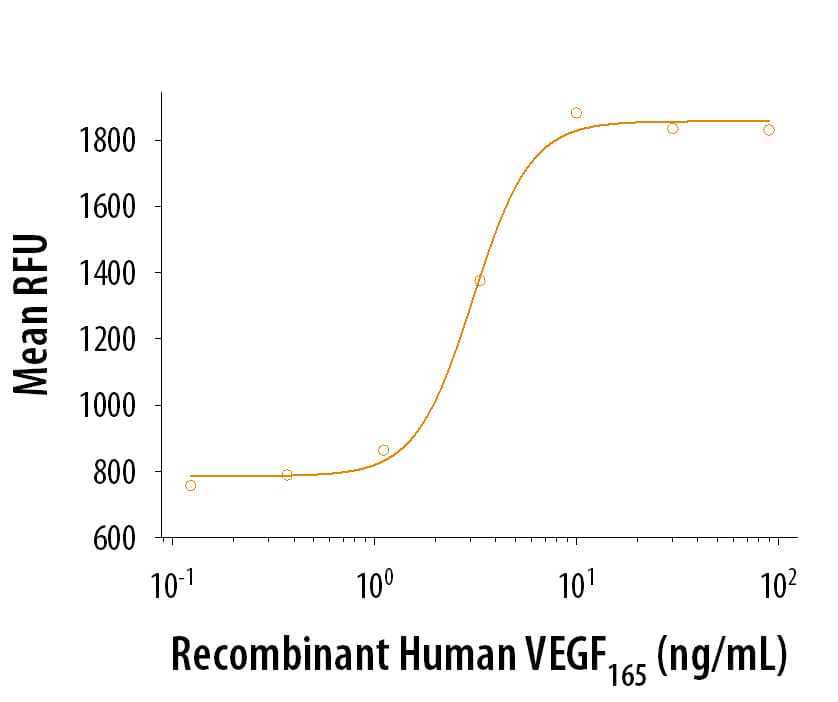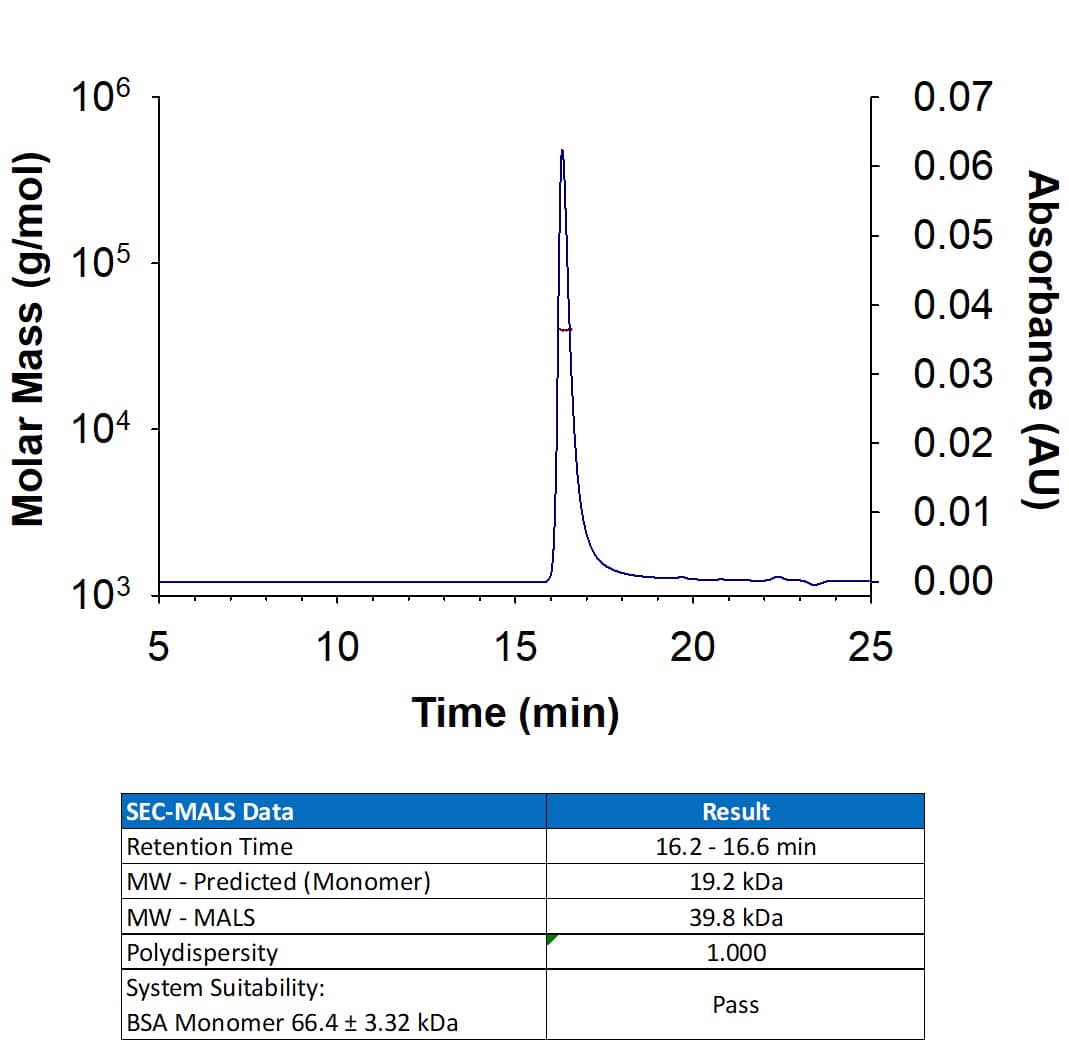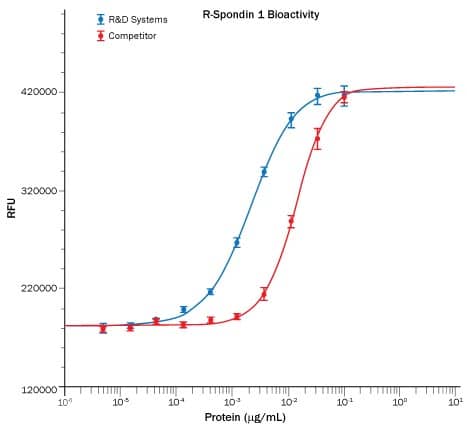Recombinant Human Dkk-1 Protein, CF Summary
Product Specifications
Thr32-His266
Analysis
Customers also Viewed
Product Datasheets
Carrier Free
CF stands for Carrier Free (CF). We typically add Bovine Serum Albumin (BSA) as a carrier protein to our recombinant proteins. Adding a carrier protein enhances protein stability, increases shelf-life, and allows the recombinant protein to be stored at a more dilute concentration. The carrier free version does not contain BSA.
In general, we advise purchasing the recombinant protein with BSA for use in cell or tissue culture, or as an ELISA standard. In contrast, the carrier free protein is recommended for applications, in which the presence of BSA could interfere.
11495-DK
| Formulation | Lyophilized from a 0.2 μm filtered solution in PBS with Trehalose. |
| Reconstitution | Reconstitute the 20 μg size at 200 μg/mL in PBS. Reconstitute all other sizes at 500 μg/mL in PBS. |
| Shipping | The product is shipped at ambient temperature. Upon receipt, store it immediately at the temperature recommended below. |
| Stability & Storage: | Use a manual defrost freezer and avoid repeated freeze-thaw cycles.
|
Scientific Data
 View Larger
View Larger
Recombinant Human Dkk‑1 Protein (Catalog # 11495-DK) inhibits Wnt-3a induced TCF reporter activity in HEK293 human embryonic kidney cells. The ED50 for this effect is 10.0-250 ng/mL.
Background: Dkk-1
Dickkopf related protein 1 (Dkk-1) is the founding member of the Dickkopf family of proteins that includes Dkk-1, -2, -3, -4, and a related protein, Soggy (1, 2). Dkk proteins are secreted proteins that contain two conserved cysteine-rich domains separated by a linker region. Each domain contains ten cysteine residues (1‑3). Mature human Dkk-1 is a 40 kDa glycosylated protein that shares 86%, 87%, 90% and 91% aa sequence identity with mouse, rat, rabbit and bovine Dkk-1, respectively. It also shares 42% and 36% aa identity with human Dkk-2 and Dkk-4, respectively. Dkk-1 and Dkk-4 are well documented antagonists of the canonical Wnt signaling pathway (1, 2). This pathway is activated by Wnt engagement of a receptor complex composed of the Frizzled proteins and one of two low-density lipoprotein receptor-related proteins, LRP5 or LRP6 (4). Dkk-1 antagonizes Wnt by forming ternary complexes of LRP5/6 with Kremen1 or Kremen2 (4, 5). Dkk‑1/LRP6/Krm2 complex internalization has been shown to down-regulate Wnt signaling (4, 5). Dkk-1 is expressed throughout development and antagonizes Wnt-7a during limb development (6, 7). Other sites of expression include developing neurons, hair follicles and the retina of the eye (8, 9). The balance between Wnt signaling and Dkk-1 inhibition is critical for bone formation and homeostasis (10). Insufficient or excess Dkk-1 activity in bone results in increased or decreased bone density, respectively (8, 11). In adults, Dkk-1 is expressed in osteoblasts and osteocytes, and neurons. Cerebral ischemia induces Dkk-1 expression, which contributes to neuronal cell death (12).
- Krupnik, V.E. et al. (1999) Gene 238:301.
- Niehrs, C. (2006) Oncogene 25:7469.
- Bullock, C.M. et al. (2004) Mol. Pharmacol. 65:582.
- Mao, B. et al. (2001) Nature 411:321.
- Mao, B. et al. (2002) Nature 417:664.
- Kemp, C. et al. (2005) Dev. Dyn. 233:1064.
- Adamska, M. et al. (2004) Dev. Biol. 272:134.
- Li, J. et al. (2006) Bone 36:754.
- Verani, R. et al. (2006) J. Neurochem. 101:242.
- Pinzone, J.J. et al. (2009) Blood 113:517.
- Morvan, F. et al. (2006) J. Bone Miner. Res. 21:934.
- Cappuccio, I. et al. (2005) J. Neurosci. 25:2647.
FAQs
No product specific FAQs exist for this product, however you may
View all Proteins and Enzyme FAQsReviews for Recombinant Human Dkk-1 Protein, CF
There are currently no reviews for this product. Be the first to review Recombinant Human Dkk-1 Protein, CF and earn rewards!
Have you used Recombinant Human Dkk-1 Protein, CF?
Submit a review and receive an Amazon gift card.
$25/€18/£15/$25CAN/¥75 Yuan/¥2500 Yen for a review with an image
$10/€7/£6/$10 CAD/¥70 Yuan/¥1110 Yen for a review without an image



















